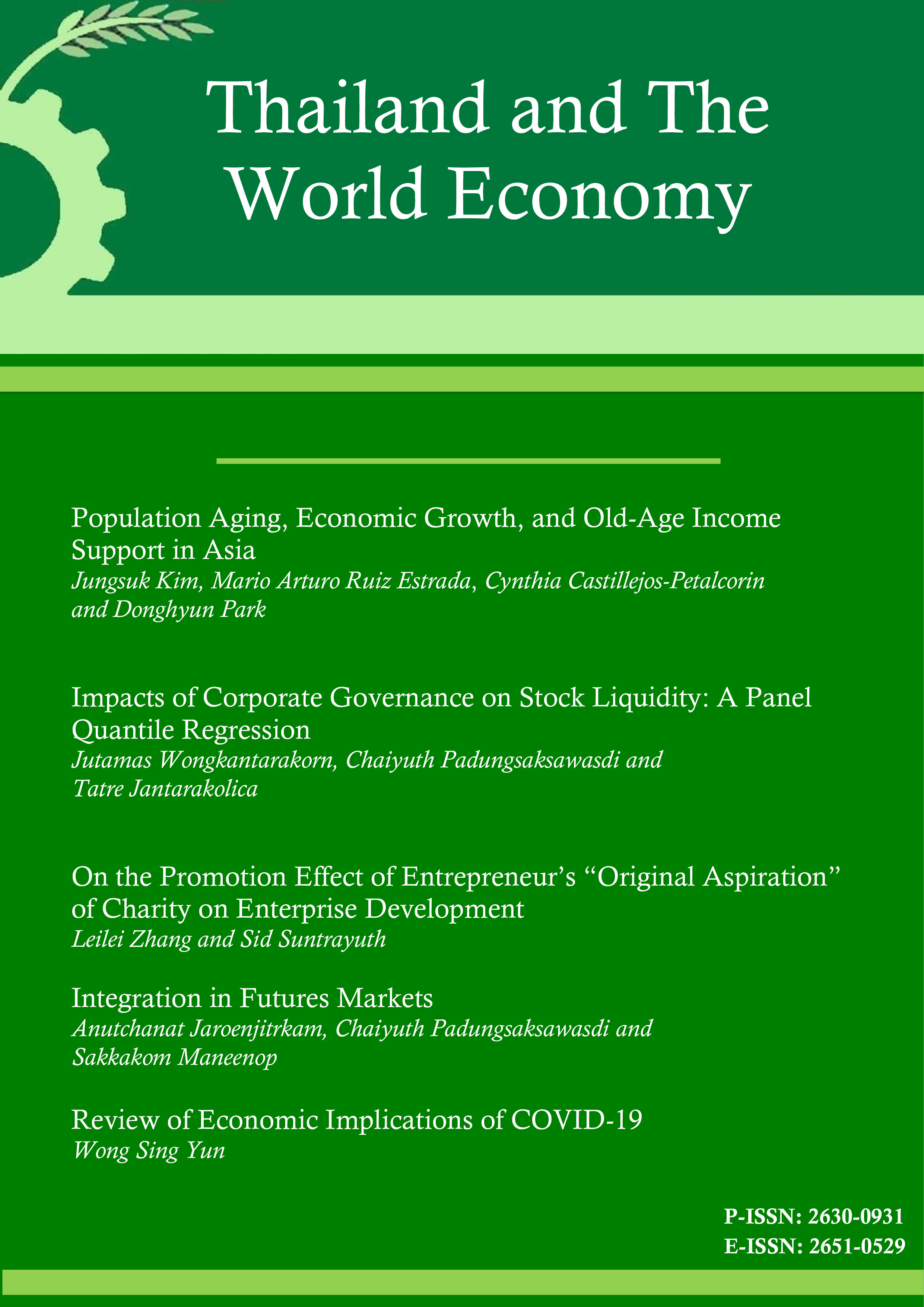Integration in Futures Markets
Keywords:
Market Integration, Futures Markets, Principal Components Analysis, Market CrashAbstract
This paper aims to examine integration in equity index futures markets around the globe, which has not been explored in prior literature. Overall, the integration in futures markets is obviously stronger than that in the associated equity markets, although a sudden decrease is observed from years 2012 to 2014 due to a reduction in the volatility of futures markets. Thus, a long memory behavior of the integration in futures markets is not present. Specifically, the degree of integration of developed futures markets is much higher than that of emerging futures markets and the integration among European futures markets are the strongest. In addition, the integration is associated with stock market crash but not with stock market jump. We conclude that benefits from cross-market diversification still exist even during a turbulent period.
References
Andersen, Torben G. (1996). Return volatility and trading volume: An information flow interpretation of stochastic volatility. The Journal of Finance, 51(1) 169-204.
Bekaert, G. (1995). Market integration and investment barriers in emerging equity markets. The World Bank Economic Review, 9(1), 75-107.
Bekaert, G., & Harvey, C. R. (1995). Time‐varying world market integration. the Journal of Finance, 50(2), 403-444.
Bhar, R. (2001). Return and volatility dynamics in the spot and futures arkets in Australia: An Intervention analysis in a bivariate EGARCH‐X framework. Journal of Futures Markets, 21(9). 833-850.
Booth, G. G., Martikainen, T, & Tse, Y. (1997). Price and volatility spillovers in Scandinavian stock markets. Journal of Banking & Finance, 21(6). 811-823.
Carrieri, F., Chaieb, I., & Errunza, V. (2013). Do implicit barriers matter for globalization?. The Review of Financial Studies, 26(7), 1694-1739.
Carrieri, F., Errunza, V., & Hogan, K. (2007). Characterizing world market integration through time. Journal of Financial and Quantitative Analysis, 42(4), 915-940.
De Jong, F., & De Roon, F. A. (2005). Time-varying market integration and expected returns in emerging markets. Journal of financial economics, 78(3), 583-613.
Daigler, R. T., & Wiley, M. K. (1999). The impact of trader type on the futures volatility‐volume relation. The Journal of Finance, 54(6), 2297-2316.
Errunza, V., & Losq, E. (1985). International asset pricing under mild segmentation: Theory and test. The Journal of Finance, 40(1), 105-124.
Errunza, V., Losq, E., & Padmanabhan, P. (1992). Tests of integration, mild segmentation and segmentation hypotheses. Journal of Banking & Finance, 16(5), 949-972.
Forbes, K. J., & Rigobon, R. (2002). No contagion, only interdependence: measuring stock market comovements. The journal of Finance, 57(5), 2223-2261.
Holmes, P., & Tomsett, M. (2004). Information and noise in U.K. futures markets. Journal of Futures Markets, 24(8), 711-731.
Hutton, A. P., Marcus, A. J., & Tehranian, H. (2009). Opaque financial reports, R2, and crash risk. Journal of financial Economics, 94(1), 67-86.
Kearney, C., & Lucey, B. M. (2004). International equity market integration: Theory, evidence and implications. International Review of Financial Analysis, 13(5), 571-583.
Khanthavit, A., & Sungkaew, J. (1993). Measuring Thailand's barriers to investment. Pacific-Basin Finance Journal, 1(4), 355-367.
Lehkonen, H. (2014). Stock market integration and the global financial crisis. Review of Finance, 19(5), 2039-2094.
Lertweeranontharat, C., Jaroenjitrkam, A., & Padungsaksawasdi, C. (2016). Noise trading behavior in Thai futures market. NIDA Business Journal, 18. 94-110.
Lin, C. C., Chen, S. Y., Hwang, D. Y., & Lin, C. F. (2002). Does index futures dominate index spot? Evidence from Taiwan market. Review of Pacific Basin Financial Markets and Policies, 5(2). 255-275.
Morck, R., Yeung, B., & Yu, W. (2000). The information content of stock markets: why do emerging markets have synchronous stock price movements?. Journal of financial economics, 58(1-2), 215-260.
Nishiotis, G. P. (2004). Do indirect investment barriers contribute to capital market segmentation?. Journal of Financial and Quantitative Analysis, 39(3), 613-630.
Pukthuanthong, K., & Roll, R. (2009). Global market integration: An alternative measure and its application. Journal of Financial Economics, 94(2), 214-232.
Samuelson, P. A. (1965). Proof that properly anticipated prices fluctuate randomly. Industrial Management Review, 6(2). 41-49.
Solnik, B., Boucrelle, C., & Le Fur, Y. (1996). International market correlation and volatility. Financial Analysts Journal, 52(5), 17-34.
Yu, I. W., Fung, K. P., & Tam, C. S. (2010). Assessing financial market integration in Asia–equity markets. Journal of Banking & Finance, 34(12), 2874-2885.










